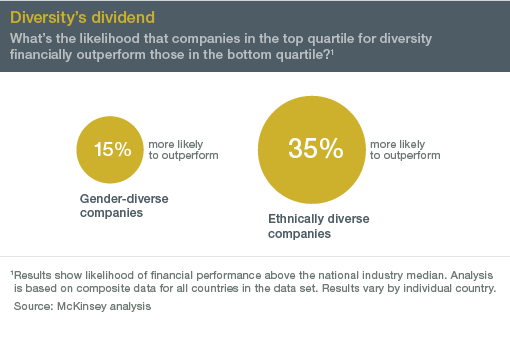Diversity and Inclusion recruitment processes and workforces are the buzz words right now. If the level of white noise was a benchmark, we should be there and all sorted. But we’re not. So what’s going on behind the hype?
Why aren’t diversity and inclusion recruitment initiatives working?
I see regular, but superficial posts about the way to get it right. But despite the social media fanfare and the business case for D & I being incontrovertible, the needle isn’t moving at the rate it should. In some cases it’s regressing. These are the stats from McKinsey, but if you go with Deloitte, Mercer, the World Bank or W.E.F. the indications are all similar.
Now companies like Microsoft and Google who seemingly go to great lengths to do everything right are struggling to shift the status quo. They are making D & I KPIs for senior management and part of their personal objectives. Essentially the message is that people can’t be relied on to do the “right” thing, they must have incentives and be rewarded for achieving specific objectives when it comes to diversity and inclusion recruitment.
Tackling bias
To tackle this, many organisations have thrown big budgets and people at unconscious bias training and awareness coaching, but without creating a safe culture where biases can be called out. Not unsurprisingly there is push back against generic programmes as employees resent the idea that they need to be “fixed.” Unconscious bias can only ever be managed in any of us. Candidates are placed because they conform to pre-conceived ideas around “cultural” fit (affinity or confirmation bias) and conversely rejected because they may not. The concept of hire for attitude rather than aptitude beyond entry-level, is something mainly seen in Twitter memes and quoted by LinkedIn influencers.
Read: Affinity bias and the recruitment process
Defining diversity
Organisations need to have a clear vision of how they define a diverse workforce, what it means for them and then clarity on the strategy they need to achieve those goals. Then there needs to be an impactful message related to the company mission statement and employee benefits that would attract that diverse workforce. These conditions need to be openly stated as this demographic self-deselect. This can be flexi-time, welcome bonuses, job sharing, disabled facilities, carer support, retirement support, mentoring programmes and education and study support. So whether diversity comes from hiring on the basis of gender, ethnicity, age, physical ability or even mental health issues, there has to be clarity on which demographics are being targeted.
Promote an employer brand based on diversity
Diversity and Inclusion recruitment drives can’t succeed in a vacuum. A positive employer branding message has to focus on the benefits of working in an organisation that supports diversity. Building relationships at grass-roots level to create a feeder talent pipeline, whether via alternative schools, community centres, colleges, NGOs, charities or women’s organisations etc;, or offering returnships to early retirees or parents. This involves having role models to act as brand and diversity ambassadors going directly into those communities to do a full-on PR job.
Spread the word
Once created this message needs to be strategically communicated where the target demographics are likely to be found. 85% of jobs are secured via networking so you can see why hiring results in “mini-mes” being selected. Many recruiters pursue low hanging, visible fruit. It means a fast, problem-free placement and easier fee. Identifying potential candidates easily tracked on LinkedIn is the quick fix option which will not support diversity. Many young recruiters don’t have the skills to do anything more imaginative and will need training on what is needed to encourage successful diversity and inclusion recruitment drives
Positions should be advertised in a wide variety of places and platforms. It is well-known that women cannot be found on STEM courses, so it’s a waste of time looking there. Yet most companies continue to do exactly that and then complain loudly they can’t find the talent. They should try looking at liberal arts courses and conducting numeracy testing at the interview stage.
Neutral selection processes
At this point the selection process should be as neutral as possible.
- Empathetic application forms – some companies still list learning differences as disabilities.
- Neutral profiles – making sure that the text usually written in an alpha male tone will not cause candidates to self-deselect.
- Blind CVs – these are useless on their own without 3,4 and 5.
- Structured interviews with open feedback and a culture of calling out and naming bias
- Short lists of 3 for the target demographic. A token minority will end up getting cut.
- Interview panels with a diverse composition.
Read: Do structured interviews overcome unconscious bias?
Organisations with a real interest in diversifying their workforce will make more concerted efforts to test new ways to identify and attract a new type of potential candidate. Unless that happens then diversity and inclusion needle will continue to stick.






